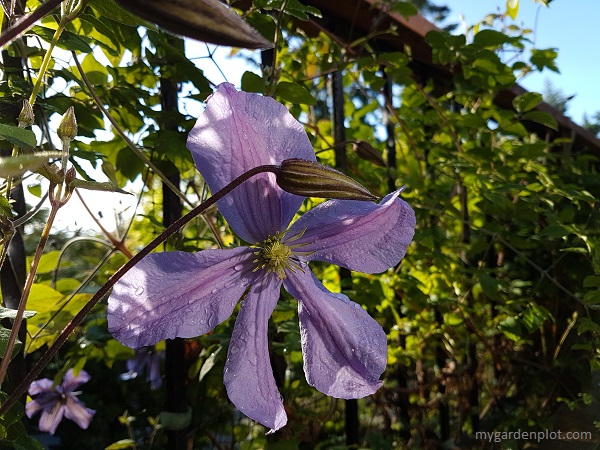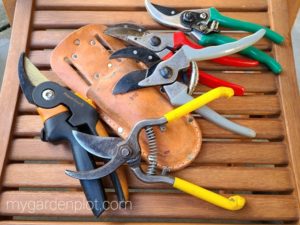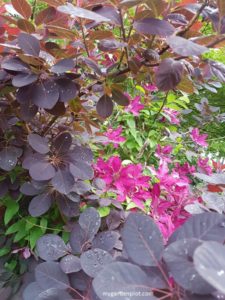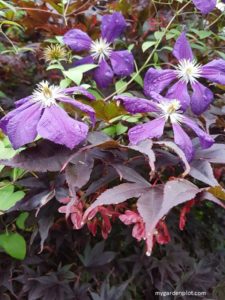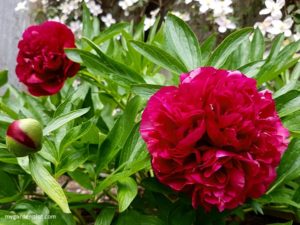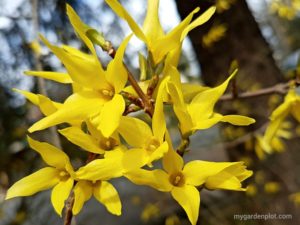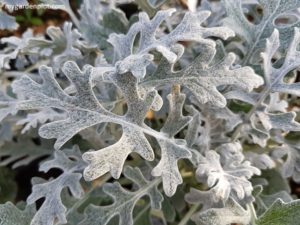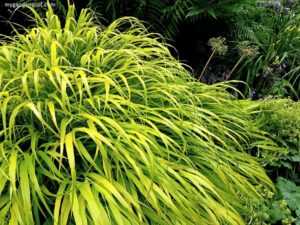Clematis Care And Practical Needs
The much-loved clematis grows very well in our corner of the world in southern British Columbia. Cool moisture-retentive but well-drained soil and relatively mild summer months make it an ideal for this popular vine. Twisting through trees or weaving their stems around a pergola, the queen of flowering climbers, is spectacular. With hundreds of species, hybrids, and varieties offering different blooming periods, it is easy to understand why this beautiful plant is one of the most popular vines worldwide. Below we break down the clematis care and tips, when and how to prune clematis, what pruning tools and support ties are needed, and practical requirements for each of the three clematis groups.
Clematis are mostly deciduous, though, there are a few evergreens that are outstandingly beautiful and fragrant.
There is a wide range of clematis varieties and likely some new hybrids to choose from suitable for your region. The easiest way to narrow down your selection is by first establishing when you want it to flower, and then by your colour preferences. As many gardeners will tell you, seldom are we happy having just one clematis plant. Once you have one, you will want another one!
Clematis Blooming Seasons
There is a wealth of fascinating botanical details for botanists and horticulturists defining the clematis species. To cut through this, the clematis types are more typically presented under the following three groups:
- Group A (or group one) – For early-season flowering clematis. Produces blooms on old wood from winter through to mid-spring.
- Group B (or group two) – For mid-season flowering clematis. Produces blooms on old wood and new stems from late spring to early summer.
- Group C (or group three) – For late-season flowering clematis. Produces blooms on new stems only from mid-summer to late autumn.
Interesting Fact About The Clematis Flower
The clematis flower does not actually have petals. What you see is the appearance of petals, which is the flower’s sepals – this is generally the most dramatic part of the clematis flower. These sepals are known as ‘tepals’. The colours vary widely from whites, yellows, and pinks through to purples and deep reds.
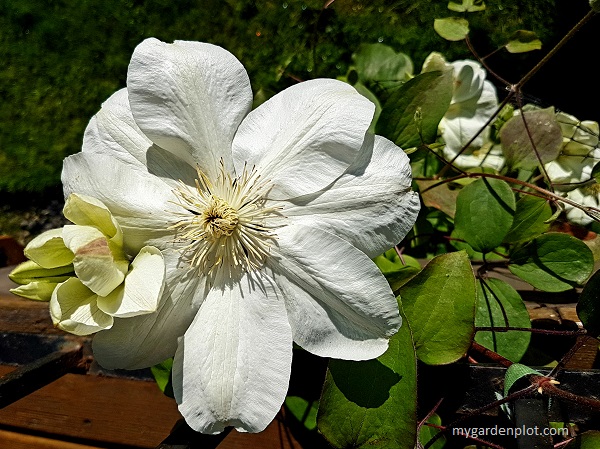
Clematis At A Glance
Type: Mostly Deciduous, Perennials / Few Evergreens
Location: Full Sun – Partial Sun
Blooming Season: Varies
Size: Varies
When To Prune: (see pruning tips below)
- Group A Early-Flowering Clematis – Late Spring / Early Summer
- Group B Midseason-Flowering Clematis – Late Winter / Early Spring
- Group C Late-Flowering Clematis – Late Winter / Early Spring
Cold Hardiness Zones: 4, 5, 6, 7, 8, 9
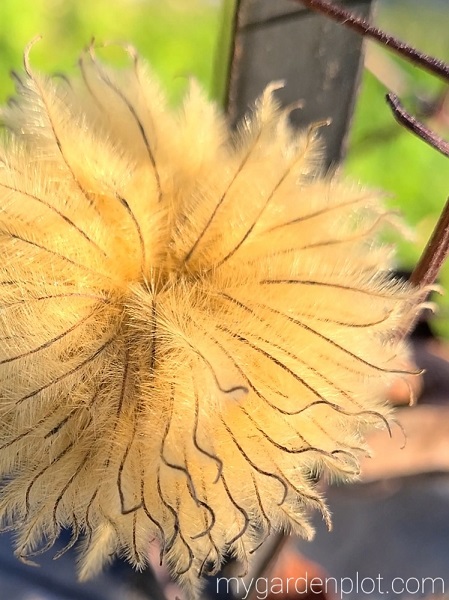
Where To Plant And How To Care for Clematis
Plant your new clematis during spring to take advantage of the warmth and growing season to establish it before winter. When planting clematis in your garden, there are three things to keep in mind the amount of sunshine the location gets, soil requirements, and the structure to support it.
Most clematis types prefer a sunny or partially sunny spot. Though there are a few varieties that can adapt to a shady location – these tend to be the spring-flowering types. Humus-rich, well-drained soil is needed and where the roots can be kept cool. In the past, gardeners would cover the area with stones to help keep the roots cool. This may be okay for an east-facing location where there is shelter from the mid-day hot sun. But a south-facing site in full sun is likely going to heat up the stones too much and increase the risk of drying out. In essence, the top of the clematis wants sun while its roots are kept cool and well-watered.
The clematis vine needs support to grow. It can be planted at the base of trees, fences, and walls, or trained to ramble over a pergola or trellis, or even recycled support forms – anything upright will do. With a little planning, these structures placed in the right location can help keep its roots cool while allowing the clematis to reach up for the full sun. Smaller varieties suitable for containers can be easily supported with a garden store or homemade tripod of bamboo canes. The creative range of support methods and ideas are endless.
The clematis is relatively easy to care for and is seldom troubled, aside from stem rot. In late winter, add compost or manure to the base of your clematis, but avoid putting it up against the main stem of the plant. If possible, work the compost into the soil. Mulch around the area of the clematis will help retain soil moisture as the weather warms up.
And now, the pruning tips! Scroll down the page for when and how to prune your clematis.
Recommend Ties And Free-standing Support Trellis When Training Clematis Vines
For ties we prefer to use velcro ties for support; they are reusable, secure but, better yet, gentle on young stems where needed. For more robust support, we use flexible wire ties that are covered with a soft covering. Particularly for our evergreen clematis, we used the flexible wire ties on stems to remain positioned for a long time. Easy to remove if we need it but strong enough to last a long time.
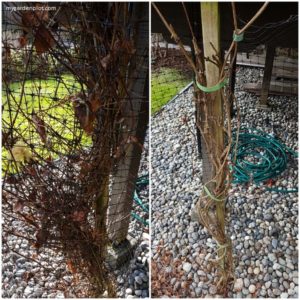
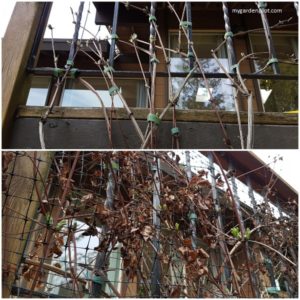
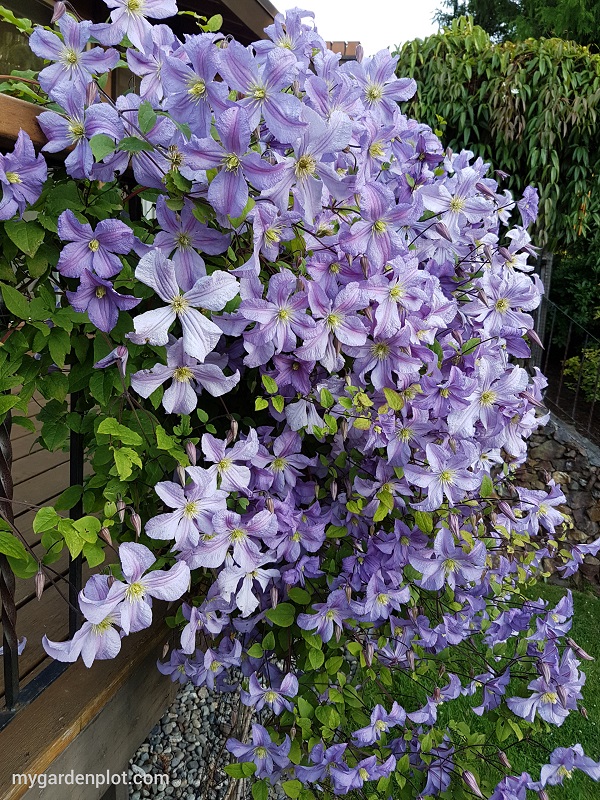
When And How To Prune Clematis
Clematis, for the most part, are vigorous growers. Some pruning is needed to regulate growth. Each group has slightly different needs. As well, this maintenance pruning helps coax the stems on their support structure. Regardless of which type, most young clematis plants will benefit from pruning back to about 30 cm (12 inches) from the base. This encourages stronger shoots from ground level and a bushy habit growth. Once your plant is more established, following is an overview of pruning requirements by group:
- Group A (or group one) Early-Flowering Clematis – Less pruning is needed for earlier blooming clematis. For length reduction or structural pruning, start soon after flowering in late spring or early summer. Cut back where required to a healthy bud. This group flowers on old wood and leaving to prune until later in the year can remove next year’s flowers. Remove any older or stray shoots to maintain a balanced and tidy framework.
- Group B (or group two) Midseason-Flowering Clematis – The best time to prune is late winter or early spring. Minimum amount of pruning for mid-season bloomers is generally needed. Light annual pruning will help keep it tidy and limit straggly stems. Remove any deadwood or any thin, weak growth.
- Group C (or group three) Late-Flowering Clematis – Schedule in regular pruning in late winter or early spring, preferably before new shoots form. This encourages the production of new shoots where late-season flowers form. Check for dead or damaged stems and remove them too. Pruning also helps control the height. It can handle cutting right down to about 30 cm (12 inches) from ground level.
Clematis are relatively tolerant when it comes to pruning. Even with too much taken off or at the wrong time, they keep coming back. At worse, you may lose the following season’s flowers. When I inherited a few mature clematis plants that were overcrowded and tangled masses, I was initially fearful that I would kill the plant. But after a hard prune, they came back and with more vigour and healthier shoots.
If you are unsure what variety or group your clematis falls into, leave it for a year. It will be apparent when it flowers the following season.
Tools Needed For Pruning Clematis
Below is the list of essential tools needed to prune any group of clematis. Annual pruning is necessary encourage a healthy growth habit and blossoms:
- Pruners – Bypass pruners are the most popular choice for gardeners and a must in a pruner’s tool kit. Bypass means the blades pass each other in a scissorlike action providing a clean cut without splintering the stem’s edge. The anvil garden pruner, where the upper blade cuts against a lower flat edge, must always be kept sharp. Otherwise, it will crush the stem while trying to cut it.
- Garden Gloves – Gardening gloves help keep hands clean and provide protection. Fabric gloves with vinyl offer a good grip on the fingers and palm. Good for warmer weather. For more challenging jobs, a pair of suede or leather gloves go a long way. Not too comfortable in warmer weather, though
Buyer's Guide To Hand Pruners (Pruning Shears, Secateurs)
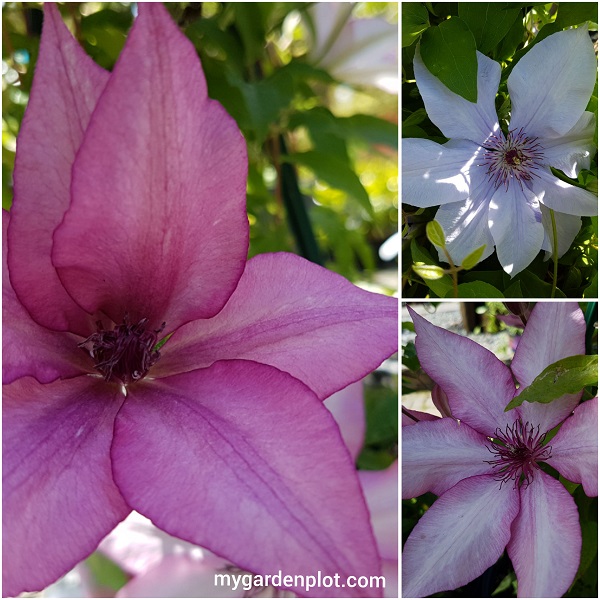
Clematis Growing On Trees
Natural supports for clematis like a tree trunk is a beautiful way to create attractive interest and contrast in a garden. The tree’s bark provides a natural grip for the clematis. Here are a couple of tree ideas.
READ MORE: Growing Smoke Trees and Japanese Maple Tree Care

